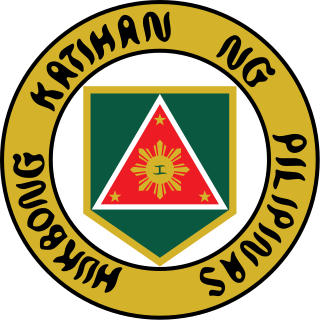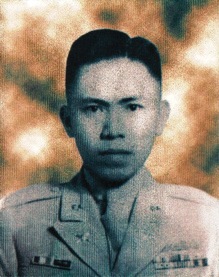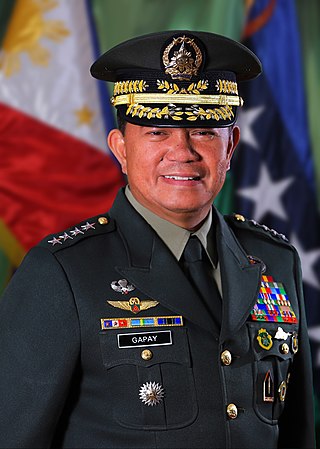Related Research Articles
The Battle of Yultong, also known as the Battle of Puluodong, Battle of Yuldong, or Battle of Yuldong-ri, took place during the Korean War. It was fought between approximately 40,000 soldiers from elements of the Chinese People's Volunteer Army (PVA) 34th Division and 900 Filipino soldiers 10th Battalion Combat Team (BCT), north of Yeoncheon during April 22–23, 1951. The battle was part of the Chinese Spring Offensive.

The Philippine Army (PA) is the main, oldest and largest branch of the Armed Forces of the Philippines (AFP), responsible for ground warfare and as of 2021 had an estimated strength of 143,100 soldiers backed by 1,400,000 ready reserves. The service branch was established on December 21, 1935, as the Philippine Commonwealth Army. The Philippine Army has engaged in many conflicts including the ongoing Communist rebellion in the Philippines, the Moro conflict and, alongside other national military forces, in conflicts of international scope.

Alfredo Manapat Santos was Chief of Staff of the Armed Forces of the Philippines in 1962 to 1965, making him the first four-star general of the Philippines' armed forces.
Captain Emilio Soriano Liwanag was an officer in the Philippine Navy who served during the Second World War and the Korean War.

Hermogenes Cendaña Esperon Jr. is a retired Philippine Army general who served as the National Security Adviser in the Cabinet of President Rodrigo Duterte from 2016 to 2022. He was the Chief of Staff of the Armed Forces of the Philippines from 2006 to 2008 and Commanding General of the Philippine Army from 2005 to 2006 under President Gloria Macapagal Arroyo. After his retirement from the military, he served in Arroyo's administration as the Presidential Adviser on the Peace Process and later as the head of the Presidential Management Staff.

Alexander Badong Yano is a retired Philippine Army general who served as the 38th Chief of Staff of the Armed Forces of the Philippines, the highest position in the AFP hierarchy. His Vice Chief of Staff was Lt. Gen. Cardozo M. Luna and his Deputy Chief of Staff was Lt. Gen. Rodrigo F. Maclang. Alexander Yano also served as the commander of the Philippine Army and Southern Luzon Command. He is also the first general born from Mindanao

The Philippine Expeditionary Force to Korea (PEFTOK) (Spanish: Fuerza Expedicionaria Filipina a Corea or FEFC, Tagalog: Puwersang Expedisyonarya ng Pilipinas sa Korea or PEPK, Korean: 필리핀 한국 원정군; RR: Pillipin han-guk wonjeonggun) was the Philippine Army contingent of the United Nations forces that fought in the Korean War (1950–1953). The unit arrived in Korea in August 1950. It was composed of 1,468 troops, and was the fifth largest force under the United Nations Command. The PEFTOK took part in the Battle of Miudong (which was hailed as the first battle won by Filipino soldiers in a foreign soil) Battle of Yultong and the Battle of Hill Eerie. The unit operated alongside the United States 1st Cavalry Division, 3rd Infantry Division, 25th Infantry Division, and 45th Infantry Division.

Rafael Manio Ileto was a Filipino general who served as the 22nd Secretary of the Department of National Defense (DND) of the Philippines. He also became the Vice Chief of Staff of the Armed Forces of the Philippines (AFP). He also served as Philippine Ambassador to Turkey, Iran, Cambodia, Thailand, and Laos.

The Philippine Military Academy also referred to by its acronym PMA is the premier military academy for Filipinos aspiring for a commission as a military officer of the Armed Forces of the Philippines (AFP). It was established on December 21, 1936, by the virtue of National Defense Act of 1935. It is patterned after the United States Military Academy, in West Point, New York. The academy is located in the city of Baguio, and serves as the primary training school for future officers of the AFP.

Eduardo San Lorenzo Oban Jr is a graduate of the Philippine Military Academy Class of 1979 and the former Chief of Staff of the Armed Forces of the Philippines. His term as chief of staff began on March 6, 2011 when he succeeded General Ricardo David and ended when he was succeeded by General Jessie Dellosa. On February 22, 2014, Oban was appointed by President Aquino to head the Visiting Forces Agreement Commission.

Delfin C. Castro was a major general of the Armed Forces of the Philippines. He was the commander of the AFP Southern Command (SOUTHCOM), from 1981 to 1986. Notable incidents during his tenure include the Pata Island massacre, the assassination of Zamboanga City Mayor Cesar Climaco, the rescue of kidnapped Bishop Federico O. Escaler from Muslim rebels and the strafing of the Japanese vessel Hegg by Philippine Air Force fighters off Mindanao.

Emmanuel Trinidad Bautista is a Filipino general who served as the 44th Chief of Staff of the Armed Forces of the Philippines as he succeeded Gen. Jessie Dellosa as AFP Chief. He served as the Executive Director of the Cabinet Cluster on Security, Justice, and Peace at the Office of the President, Malacañang. His appointment as Undersecretary at the Office of the President was from 1 September 2014 to 22 June 2020 shortly after retirement from the military service as Chief of Staff, Armed Forces of the Philippines. Concurrently, he headed the National Task Force on the Whole of Nation Initiative and was also the executive Director of the National Task Force on the West Philippine Sea. He was succeeded by Gregorio Pio Catapang as AFP chief.

Conrado Dumlao Yap was a officer in the Philippine Army who served during the Second World War and the Korean War.

Bartolome Vicente "Bob" Orpilla Bacarro is a retired Philippine Army lieutenant general who served as the 58th chief of staff of the Armed Forces of the Philippines from 2022 to 2023. He previously commanded the Southern Luzon Command. In 1991, Bacarro was awarded the Armed Forces of the Philippines Medal of Valor for his actions against the New People's Army in Maconacon, Isabela.
Colonel Venancio Merioles Serrano also known as "Bonny" Serrano, was a Filipino soldier of the Korean War in the 1950s. He received a total of 48 medals, including the Medal of Valor for extraordinary bravery, the highest honor the Armed Forces of the Philippines (AFP) can bestow. He was a member of the 10 BCT Philippine Expeditionary Force to Korea (PEFTOK): 1950–1955.

Victor Navarro Corpus was a Filipino military officer and public official best known for his 1970 defection from the Armed Forces of the Philippines (AFP) to the New People's Army of the Communist Party of the Philippines during the authoritarian regime of Ferdinand Marcos, for his defection from the NPA in 1976, his return to the AFP after the 1986 People Power Revolution, and his later role as chief of the Intelligence Service of the Armed Forces of the Philippines (ISAFP).
Allan Ferdinand Valdez Cusi is a Filipino Admiral who served as the former Superintendent of the Philippine Military Academy after Lt. Gen. Ronnie Evangelista resigned over the hazing case and the Death of Darwin Dormitorio He is a graduate of the PMA "Sinagtala" Class of 1986.

Gilbert Italia Gapay is a retired Philippine Army general who served as the 54th Chief of Staff of the Armed Forces of the Philippines. Prior to his appointment, he served as the 61st Chief of the Army and the commander of the Armor "Pambato" Division.

The Sinagtala Class of 1986(English: light from above, lit. Starlight) was the first to graduate from the Philippine Military Academy (PMA) after the 1986 People Power revolution, and the first batch of new military officers to serve the administration of the late President Corazon Aquino.

Romeo Saturnino Brawner Jr. is a Philippine Army general who has served as the 60th Chief of Staff of the Armed Forces of the Philippines since July 21, 2023. Prior to his appointment to the post, Brawner previously served as the 64th Commanding General of the Philippine Army.
References
- ↑ "PMA Quick Facts". Philippine Military Academy. 2016-07-27. Retrieved 2020-03-26.
- 1 2 Pazzibugan, Donna (February 21, 2011). "Amid Scandal, 92-year-old PMA grad inspires cadets". Philippine Daily Inquirer.
- ↑ The Philippine Army : Keeping its Covenant with the Nation. Army Troopers Newsmagazine, March 2012, 7-8.
- ↑ Interview with General Reynaldo Mendoza (ret.), Camp Aguinaldo, 13 August 1996; Major Rogelio S. Lumabas, Wither the MAP, The Cavalier 7, no. 1 (November – December 1967), 5-6, qtd. in Alfred McCoy, Closer than Brothers : Manhood at the Philippine Military Academy (Yale University Press, 1999), 3, note 1.
- ↑ "PMA Pioneer Class of 1940". Angkang Pilipino. 2014-02-25. Retrieved 2020-03-24.
- ↑ Theorex (August 31, 2011). "THE PMA CADET: PMA, Oh Hail To Thee". The PMA Cadet.
- ↑ Romero, Alexis (February 21, 2011). "PMA pioneering class grad says no to abolition". The Philippine Star.
- ↑ Karsten, Peter (1998). The training and socializing of military personnel. New York : Garland Pub. ISBN 978-0-8153-2976-3.
- ↑ Ralph (2011-07-20). "Philippine Military Academy Alma Mater Song | Trunk Locker". Philippine Military Academy Alma Mater Song | Trunk Locker. Retrieved 2020-03-25.
- ↑ McCoy, Alfred (1999). Closer than Brothers: Manhood at the Philippine Military Academy. Yale University Press. pp. 85, 199. ISBN 978-0-300-19550-7.
- ↑ McCoy, Alfred (August 1955). "Same Banana: Hazing and Honor at the Philippine Military Academy". Journal of Asian Studies. 54 (3): 709. JSTOR 2059448.
- 1 2 3 4 5 6 Registry Committee, AGFO (1977). General and flag officers of the Philippines (1896 - 1977). Quezon City: Association of general and flag officers. p. 184.
- ↑ "Appreciating the context of President du30's visit to South Korea". Manila Bulletin News. Retrieved 2020-03-25.
- ↑ Cal, Ben. "FVR recalls sterling feat of PH combat forces in Korean War". www.pna.gov.ph. Retrieved 2020-03-25.
- ↑ Villasanta, Art (2009-12-12). "The Philippine Expeditionary Force to Korea (PEFTOK): 1950-1955: 2nd BATTALION COMBAT TEAM". The Philippine Expeditionary Force to Korea (PEFTOK). Retrieved 2020-03-25.
- ↑ BERNAD, MIGUEL A. (1957). "Philippine Bibliographical Survey: 1956". Philippine Studies. 5 (1): 71–84. ISSN 0031-7837. JSTOR 42720367.
- ↑ Greitens, Sheena Chestnut (2016). Dictators and their Secret Police. Cambridge University Press. p. 224. ISBN 978-1316505311.
- ↑ "G.R. No. L-16975". lawphil.net. Retrieved 2020-03-24.
- ↑ Malinis, Rolando C. (2015). Brothers: The Untold Story of the Philippine Military Academy Matatag Class of 1971. Independent Publisher. p. 5. ISBN 9781495138621.
- ↑ "Official Week in Review: September 1 – September 15, 1966 | GOVPH". Official Gazette of the Republic of the Philippines. Retrieved 2020-03-24.
- ↑ "Official Week in Review: August 6 – August 14, 1967 | GOVPH". Official Gazette of the Republic of the Philippines. Retrieved 2020-03-24.
- 1 2 Mendoza, Amado Jr. (June 11, 2001). "Bytes, Business & Governance (22)". Think Centre.
- ↑ "Administrative Order No. 501, s. 1985 | GOVPH". Official Gazette of the Republic of the Philippines. Retrieved 2020-03-24.
- ↑ Mendoza, Golden Book, 125, qtd. in Alfred McCoy, Closer than Brothers : Manhood at the Philippine Military Academy (Yale University Press, 1999), 340, note 3.
- ↑ Interview with Reynaldo Mendoza, in Closer than Brothers : Manhood at the Philippine Military Academy (Yale University Press, 1999), 108, note 19.
- ↑ "Ninoy Aquino, FVR get Korea war hero medal". Philippine Daily Inquirer. December 21, 2010.
- ↑ Villasanta, Art. "PEFTOK Korean War Memorial Hall". peftokmuseumph. Retrieved 2020-03-25.
- ↑ Nepomuceno, Priam. "PA inaugurates memorial for Filipino veterans of 1950-53 Korean War". bayanihan.org. Retrieved 2020-03-25.
- ↑ "General Reynaldo Arce Mendoza". geni_family_tree. Retrieved 2020-03-24.
This article needs additional or more specific categories .(January 2021) |